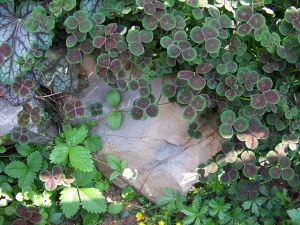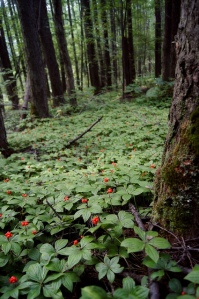Covering your extra growing space with a groundcover can give the garden and the gardener many benefits. First, cover crops will block out sunlight and crowd bare soil preventing any invasive species or weeds from sprouting. The reduction in weeds also translates into less labor for the gardener and save a lot of time pulling out unwanted plants. Cover crops also help improve soil function. They help to build and stabilize the soil while also reducing water loss from evaporation. Depending on the types of plants you choose, they can also help to prevent pests and diseases from invading.

Photo Courtesy of: Patrick Standish
Benefits of Groundcover Plants
Ground cover plants can and should be used whenever and wherever there is extra growing space. Some ground cover species can even stand to be walked on, which makes them perfect for your walkways, paths and the space between cobblestones. There are also many edible ground covers that work well for an awkward corner in your garden or even an extra space in pots indoors. I personally like to plant lettuce and other salad mixes on the edges of most of my house plants.

Photo Courtesy of: U.S. Department of Agriculture
Types of Groundcover Plants
There are many different types of ground cover species you can use for your garden. Which species to use depends on location and needs. There are soil-stabilizing species such as St. John’s Wart, Kinnickinick or strawberry plants. Strawberries are also one of many edible ground cover species including lettuce, thyme and spinach. Some examples of cover crops that keep pests away from the garden are lemon basil, wormwood and peppermint. It’s best to do some investigating on which groundcover suits your needs before planting.

Photo Courtesy of: Patrick Standish
Taking Care of Groundcovers
Most ground covers need very little maintenance in order to thrive. One of the main reasons why groundcovers are a good choice is to change a dull, dry patch of ground into an easily maintained corner of your area.

Photo Courtesy of: Tatters ❀
It is best to check the requirements of the species you are planting, but normally you should plant groundcover species in early spring or summer so they have a chance to establish themselves before winter. Most groundcovers also need very little water, so only water them when the soil is especially dry. Late winter to early spring is the best time to remove any dead or bruised leaves to make room for healthy new leaves to grow.
Resources:
Here’s a more detailed look at soil-stabilizing groundcover options: http://www.ecy.wa.gov/programs/sea/pubs/93-30/table3.html
Photo: Patrick Standish
Jake Frazier is an outdoor enthusiast and the owner of Residential Ecology, a sustainable ecological resource management company. He uses existing natural systems to improve the quality of life for both humans and the Earth. Jake is interested in permaculture, living systems and exploring. Connect with him on LinkedIn.


Reblogged this on Residential Ecology.
LikeLike
[…] the article on World Organic News or the original article here on Aquaberry […]
LikeLike
[…] via Growing Groundcover Crops | Aquaberry Bliss. […]
LikeLiked by 1 person